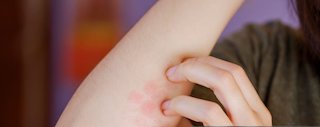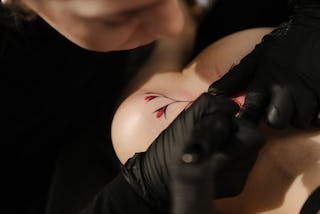Causes And Symptoms Of Infant Ringworm

Causes And Symptoms Of Infant Ringworm
Ringworm is a common fungal infection that can affect individuals of all ages, including infants. Though the name ringworm might suggest that the condition is caused by worms, it is, in fact, a skin infection caused by dermatophytes, a group of fungi that thrive on keratin, a protein found in the skin, hair, and nails. In infants, ringworm can be a source of concern due to its potential to cause discomfort and irritation.
In this comprehensive guide, we will explore everything you need to know about infant ringworm, from its causes and symptoms to how it is diagnosed and treated. By understanding this condition, parents and caregivers can take appropriate steps to manage it effectively, ensuring the well-being of their little ones.
Infant ringworm
Infant ringworm is a superficial fungal infection that can affect the skin, scalp, and nails. When ringworm affects infants, it generally appears as circular, red, scaly patches with raised borders and clear centers. The infection is contagious and can spread easily from person to person or from animals to humans.
Though ringworm is typically harmless, it can lead to significant discomfort, especially in young children with delicate skin. While the infection can appear anywhere on the body, infant ringworm is commonly found on the face, scalp, and sometimes the feet or diaper area.
Role of fungi in infant ringworm
The main cause of ringworm in infants is a type of fungus called dermatophytes, which includes 3 main species. They are Microsporum, Trichophyton, and Epidermophyton. These fungi thrive in warm, moist environments and infect the skin, hair, and nails by feeding on keratin. Dermatophytes are typically found in communal areas such as locker rooms, swimming pools, and daycare centers, making young children more vulnerable.
While ringworm can affect infants of any age, it is most common in babies who are just beginning to explore their environment, such as crawling or walking. These activities can bring them into contact with contaminated surfaces, making it easier for the infection to spread.
Causes and risk factors for infant ringworm
Ringworm in infants can be caused by several factors. In addition to the direct transmission of fungal spores, environmental and physical conditions can increase the likelihood of an infant contracting ringworm.
1) Contact with infected animals: Ringworm is often contracted through direct contact with infected animals, particularly cats and dogs. If an infant has close contact with a pet that carries the fungus, there is an increased risk of transmission. Infected animals may not always show visible symptoms, so be vigilant about their pets’ health.
2) Close contact with infected people: Since ringworm is highly contagious, an infant can also contract the fungus from infected individuals. Daycares, nurseries, and playgroups are places where children are at a higher risk of picking up ringworm from other children who may have the infection.
3) Warm and humid environments: Dermatophytes thrive in warm, moist environments. Infants who sweat a lot or wear wet diapers for prolonged periods are at a higher risk of developing ringworm in areas where moisture accumulates, such as the groin, feet, or scalp.
4) Weak immune system: An infant with a weakened immune system, due to conditions like prematurity, diabetes, or HIV, may be more vulnerable to infections like ringworm. Infants with compromised immune systems may also take longer to recover from infections.
5) Poor hygiene practices: Infants who are not kept clean or who are exposed to dirty or contaminated environments are at a higher risk of developing ringworm. For example, sharing towels or wearing unwashed clothing and blankets can increase the chances of fungal transmission.
Symptoms of infant ringworm
Recognizing the symptoms of ringworm in infants is essential for prompt treatment. The signs and symptoms of ringworm in infants can vary depending on the location of the infection and its severity.
1) Circular, red patches: The hallmark sign of ringworm is the appearance of round, red patches with raised, scaly edges and a clear or less-inflamed centre. These patches are often itchy and can appear anywhere on the body, but are most commonly found on the face, scalp, or limbs.
2) Itching and discomfort: Ringworm is usually itchy, and an infant with ringworm may scratch at the infected area or show signs of discomfort when touched. The itching is often worse in warm or humid conditions.
3) Hair loss: If the infection affects the scalp, you may notice hair loss in the area surrounding the infected patches. The fungus can weaken the hair follicles, causing the hair to fall out. The patches may become more noticeable as the skin becomes scaly.
4) Crusting and flaking: The infected skin may become crusty or flaky, particularly around the edges of the lesions. In some cases, the skin may break open and form sores that can ooze a yellowish discharge.
5) Swelling and redness: In some instances, ringworm infections can cause the skin to become swollen and red, especially around the edges of the lesion. If the infection spreads, the affected area may become increasingly inflamed.
6) Rash in the diaper area: When ringworm affects the diaper area, it may cause a red, circular rash that can be mistaken for a diaper rash. However, unlike diaper rashes, ringworm lesions often have clear centers and raised edges.
How is infant ringworm diagnosed?
If you suspect that your infant has ringworm, have them examined by a paediatrician or dermatologist for a proper diagnosis. Since ringworm can resemble other skin conditions, accurate diagnosis is crucial for determining the best course of treatment.
1) Physical examination: Your healthcare provider will begin by performing a physical examination of the affected area. They will look for signs of ringworm, such as circular patches with raised edges and clear centers. They will also check for other signs of infection, like swelling or discharge.
2) Wood’s lamp examination: A wood’s lamp is a special ultraviolet light that can help detect certain types of fungi. Some species of dermatophytes, such as Microsporum canis, will fluoresce under UV light, making them easier to identify.
3) Skin scraping and microscopic examination: If necessary, your doctor may take a small sample of skin from the affected area using a sterile scalpel. The sample is then examined under a microscope to look for fungal spores or hyphal elements, which confirm the presence of ringworm.
4) Fungal culture: A fungal culture may be performed to identify the specific type of fungus causing the infection. A sample from the infected area is cultured in a laboratory to grow the fungus, which can then be identified.
5) Biopsy: In rare cases, if the infection does not respond to standard treatments, a skin biopsy may be taken to rule out other conditions, such as eczema, psoriasis, or allergic reactions.
Treatment for infant ringworm
The treatment for infant ringworm primarily involves antifungal medications to kill the fungi and reduce symptoms. Treatment must be managed by a healthcare provider, especially in young infants.
1) Topical antifungal creams or ointment
The initial line of treatment for mild cases of infant ringworm is topical antifungal creams. These creams contain antifungal agents such as clotrimazole, miconazole, or terbinafine, which are effective at eliminating the fungus.
-
-
-
- Application: The cream should be applied directly to the affected area, typically twice a day, as recommended by the doctor. Be sure to cover the entire infected area and surrounding skin.
- Duration: Treatment usually lasts for 2 to 4 weeks, and it’s important to continue applying the medication for the full course, even if the symptoms improve.
-
-
2) Oral antifungal medications
In more severe cases or if the infection involves the scalp or nails, your paediatrician may prescribe oral antifungal medications, such as griseofulvin or itraconazole. These medications help treat the infection from the inside out and are typically used for more widespread or persistent cases.
-
-
-
- Dosage: The oral medication is usually given for 2 to 6 weeks, depending on the severity of the infection.
- Monitoring: Regular follow-ups with the doctor are necessary when using oral medications to ensure there are no side effects or complications.
-
-
3) Proper hygiene and care
Keeping the affected area clean and dry is crucial for recovery. Wash the skin gently with mild soap and water, and make sure the area is thoroughly dried before applying antifungal medication. Avoid scratching the infected area to prevent secondary bacterial infections and scarring.
4) Preventing spread
Since ringworm is highly contagious, take precautions to prevent the infection from spreading to other parts of the body or to other people.
-
-
-
- Hand washing: Wash your hands thoroughly after applying medication or touching the infected area.
- Avoid sharing items: Do not share towels, bedding, or clothing between the infected infant and other people.
- Clean environment: Disinfect any surfaces that the infected infant may come into contact with, including toys, changing tables, and diaper-changing stations.
-
-
5) When to seek medical help
If your infant’s ringworm does not respond to treatment, appears to worsen, or if you notice any signs of secondary infection, contact your healthcare provider for further evaluation.
Prevention of infant ringworm
While it may not always be possible to prevent ringworm, there are several steps parents and caregivers can take to reduce the risk of infection.
1) Maintain proper hygiene: Good hygiene is essential for preventing ringworm. Regularly wash your infant’s skin, especially areas prone to moisture, such as the diaper area and folds of skin. Change diapers frequently to keep the area dry.
2) Limit exposure to infected animals and people: Keep your infant away from pets or other individuals who may be infected with ringworm. If you have pets, ensure they are regularly checked by a veterinarian for signs of ringworm.
3) Clean shared surfaces: Clean and disinfect surfaces that your infant comes into contact with, including toys, furniture, and floors. Avoid letting your infant walk barefoot in public areas, such as swimming pools, locker rooms, or daycare centres.
Diagnose and treat early enough
Ringworm is a common yet treatable fungal infection that can affect infants. Early detection, appropriate treatment, and good hygiene practices are key to managing the condition effectively. If you notice any signs of ringworm in your infant, consult your pediatrician for an accurate diagnosis and treatment plan. With prompt care, most cases of infant ringworm resolve quickly and without complications.



